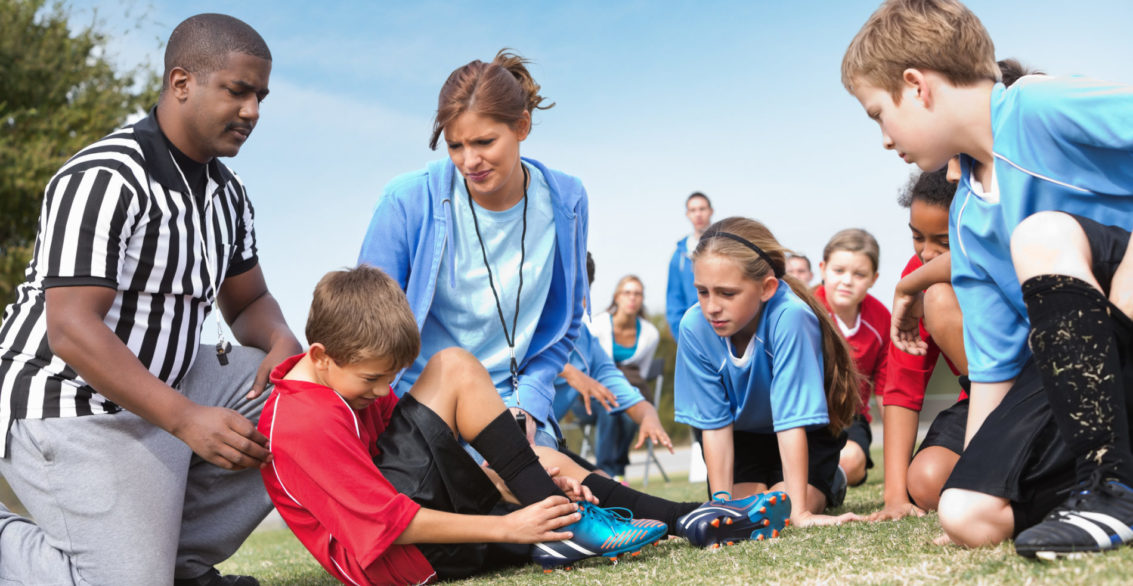Tackle. Dunk. Kick. Flip. Dive. The human body accomplishes some pretty incredible feats when at play — and most of the time, it does so unscathed. But injury can strike even the most talented athletes when they take the field or hit the court, and youth athletes are no exception. According to data from the Centers for Disease Control and Prevention, sports injuries are the top reason kids 12 to 17 visit the emergency room, and 40 percent of all sports injuries occur in kids 5 to 14.
Eric Edmonds, M.D., director of orthopedic research and co-director of 360 Sports Medicine at Rady Children’s Hospital-San Diego, says that while any sport presents risk for injury, some are inherently more dangerous. “If you take the standard school sports, football is going to have the highest injury rate, followed by the other contact sports. The incidence of injury goes down based on the prevalence of contact.” Common issues include injuries from “cutting,” or rapidly changing direction while running, with ACL tears leading the pack; shoulder injuries; sprains; and fractures, especially to the hands and wrists. Dr. Edmonds adds that more extreme sports tend to lead to more extreme injuries. “With the popularity of X Games types of activities, between motocross and skateboarding and higher-risk activities like Parkour, we are seeing an overall higher incidence of really significant injuries.”
While it’s impossible to completely prevent kids from getting hurt, there are a few honest mistakes parents, coaches and athletes often make that can impede injury prevention or proper recovery, explains Dr. Edmonds. These include the following:
- Working out without cross-training. “Cross-training doesn’t necessarily mean doing CrossFit; it’s doing different sports and different activities at different times of the year,” Dr. Edmonds says. He suggests one activity in particular to keep young sports enthusiasts in optimal shape: yoga. “Some kids may not want to do yoga, so finding ways to achieve the benefits of yoga can still work if the elements can be incorporated. It’s working on core strength and flexibility, particularly the hip core for athletes who do a lot of running, or shoulder stabilizers and core strength to protect the upper body for overhead athletes. As kids become older, their bodies become bigger and stronger and they’re competing against bigger and stronger individuals, and lack of balanced muscle health or limited flexibility and poor core strength can lead to significant injuries even without contact.”
- Not taking a break. “Kids should be taking at least a three-month hiatus from sports every year. It’s also important to not actually exercise or perform a sport more hours per week than the age of the child — these are recommendations from the American Academy of Pediatrics,” comments Dr. Edmonds. “Athletes [themselves] are often culprits because they want to do a lot of the activity and kind of drive it, but that’s how they perpetuate their injuries. Not allowing them to participate, while psychologically very difficult, is sometimes the more important thing to do. This allows them to truly rest and keep them from getting hurt.”With the recommendations from the medical academy in mind, general strength and flexibility training should continue in the offseason.
- Giving youth too much credit. “A lot of us may think that young people can tolerate bad mechanics because they’re young, but that will eventually catch up with them,” Dr. Edmonds states.
In the event injury does occur, “the most important thing is to identify that injury — seek out medical care, whether through an athletic trainer, a team physician, your primary care physician, or urgent or emergency care,” emphasizes Dr. Edmonds. “We see a lot of broken fingers and wrists that go untreated until the season is over, and that can actually cause significant long-term damage to those joints. Be cognizant that a sprain or a jammed finger could be more.”
Sometimes, though, the “walk it off” mentality many athletes embrace can apply. “My basic guideline is if you have an injury that results in an immediately swollen joint, then more than likely you should seek out medical care. If there’s no swelling, you might be okay to progress. Ease back into activities and cross-train, reducing load on the injured body part. If you’re not feeling better two weeks out, see a doctor,” Dr. Edmonds recommends. He adds one caveat: A child who sustains a head injury, even one that seems minor, should always have that injury immediately assessed by a medical professional.
